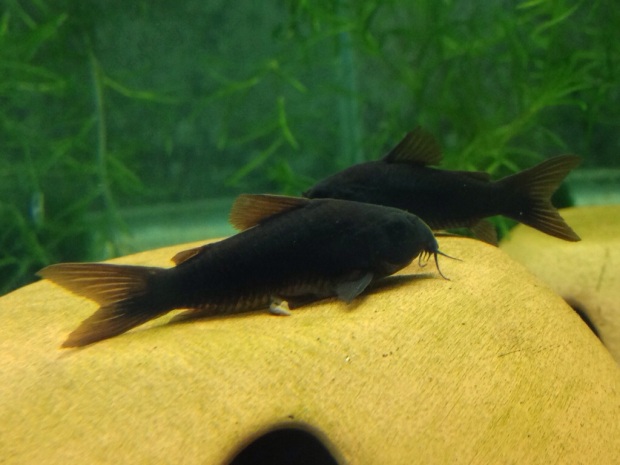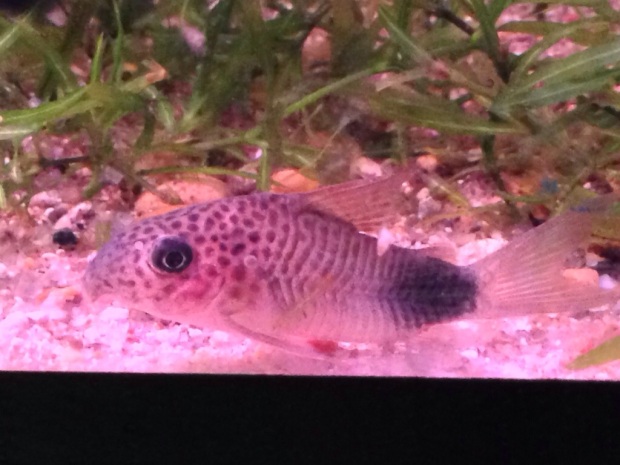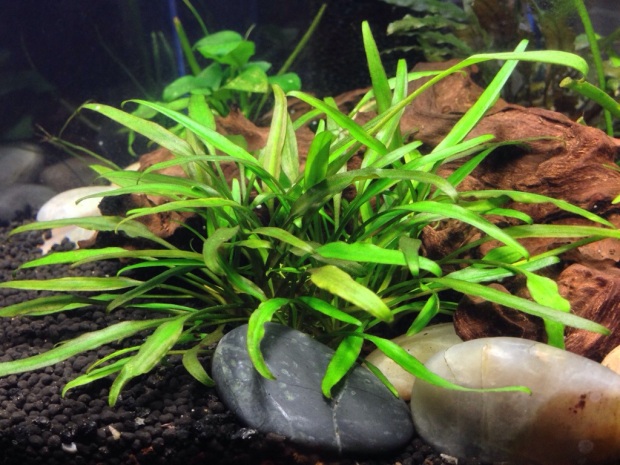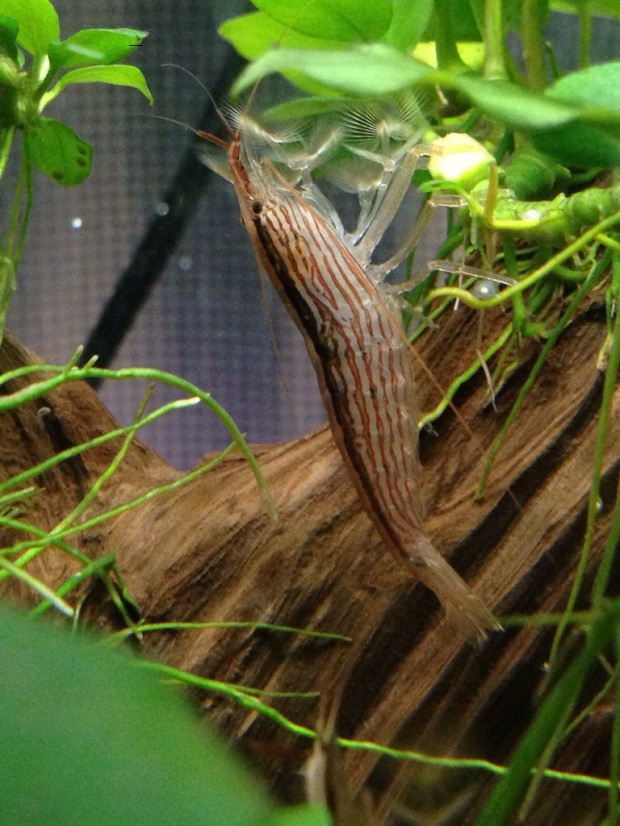What’s Happening?
Posted by lasaquatics in Uncategorized on March 27, 2014
Winter was downtime for my fishroom, and because it was unusually cold for an unusually long period of time, my water changes and maintenance got off track… it’s warming up now and stuff is starting to come back into shape. Greg set up air for all the tanks so I was able to lose about 8 little air pumps in favor for a big quiet pump, and I traded out most of my nasty standard aquarium hood lights for some nice, sleek T-5’s that zip-tied nicely to the bottom of the shelf above each row of tanks. A timer here and there and my plants should be happy.
In February, our club held an auction and I got my hands on some new critters… I grabbed some cute little Dwarf Red Tuxedo Platies, a few Keyhole Cichlids, another several Dario darios, and a berried Electric Blue Crayfish, who has since had her babies… all are doing well and they’re growing VERY fast! I also won a catfish raffle and managed to get a couple of pretty little L204’s. Not long after the auction I grabbed a small group of Corydoras habrosus from a LFS as well.
I have quite a few baby Neolamprologus multifasciatus, and baby bristlenose EVERYWHERE. I even got a cluster of mystery snail eggs, but I’m not sure at this point if they’re even fertile. I have baby livebearers running out my ears… guppies, metallicus, and several different goodeid species.
One shrimp tank (the one containing the crystal reds) has had a population implosion 😦 and my plant/shrimp jar is chock full of cherry shrimp.
Once I get the next round of water changes out of the way (and much-needed spring cleaning), I’ll start posting pics and videos again. Stay tuned!
exLamprologus multifasciatus with Fry (video)
Posted by lasaquatics in cichlids, fish, shell-dwellers, videos on December 14, 2013
So I was sitting here minding my own business and starting off into space, being the far left corner of the multifasciatus tank, and lo and behold… what did I see?
Albino Bristlenose 2013-D
Posted by lasaquatics in ancistrus, catfish, pleco types on November 28, 2013
This time I decided to wait until I knew for sure that the eggs the male was guarding were actually hatched before I took them. I noticed the eggs a full six days ago, and can only account for the delayed hatching by cooler water temperature… or it could just be that I haven’t noticed previous clutches right away. In an effort to save time, I decided to take a picture and count the fry in a freeze-frame…. much easier. I counted 166… largest spawn this year.
Corydoras schultzei ‘black’
Posted by lasaquatics in catfish, corydoras, fish on November 24, 2013
exLamprologus multifasciatus (video)
Posted by lasaquatics in cichlids, fish, shell-dwellers, videos on November 22, 2013
Also known as ‘Lamprologus’ multifasciatus, or formerly as Neolamprologus multifasciatus, this tiny shell-dwelling cichlid from Lake Tanganyika in Africa is ideally suited for smaller aquariums, and does quite well even when crowded, as this is how it lives in nature. Filtration rated for a larger tank is important for this reason, and the intake should be covered with a sponge to prevent tiny fry from being sucked in.
Corydoras similis
Posted by lasaquatics in catfish, corydoras, fish on November 21, 2013
Cryptocoryne lucens
Posted by lasaquatics in cryptocorynes, plants on November 21, 2013
This hardy crypt grows in clumps, mostly emersed in nature, but does quite well in aquariums with low to medium lighting, temperatures between 70 and 82 degrees Farenheit, and a pH range of 6.5-8.0. It’s rich green color and resemblance to grass make it an excellent foreground or mid ground plant, and provides cover for small fry and shrimp. Its compact size and shape (maximum 6″) make it a great choice for very small aquariums.
Sakura Red Cherry Shrimp in Plant Jar with Babies
Posted by lasaquatics in Invertebrates, nano, shrimp, videos on November 20, 2013
I turned an old cookie jar into a desktop aquarium, complete with live plants, olive and horned nerite snails, and Cherry Shrimp. I light the jar using a plain LED desk lamp on a timer. A few days ago, I noticed several super tiny shrimplets zooming around!!
Bamboo Shrimp
Posted by lasaquatics in Invertebrates, shrimp on November 14, 2013
Bamboo Shrimp (Atyopsis moluccensis) is a large species of filter feeding shrimp with “fans” instead of claws, rendering them harmless to fish. Unfortunately, their specialized feeding needs and sensitivity to ammonia and nitrites can make them difficult to keep alive. A planted tank is best, and finely crushed flake and baby brine shrimp, along with regular water changes will keep them happy. When they are perched on a plant or a bit of driftwood ‘catching’ bits of food out of the water column, they are content. If you find them on the substrate trying to eat off the floor, they’re hungry.
Farlowella vittata
Posted by lasaquatics in catfish, fish, other catfish on November 9, 2013
Farlowella vittata is a twig catfish from Venezuela and Colombia. It lives among plants and roots along the banks of flowing waters. Males guard the eggs while they incubate, and other females often come along to add to the brood. After hatching, the young use up their yolk sac quickly and then have a most voracious appetite. The #1 cause of loss of Farlowella fry is starvation. They need very soft vegetable-based food, and lots of it to survive. We have had the best luck with Repashy foods, which comes as a powder and is mixed with water to make a gel that can be cut into blocks that the fry can graze from all day.















Recent Comments